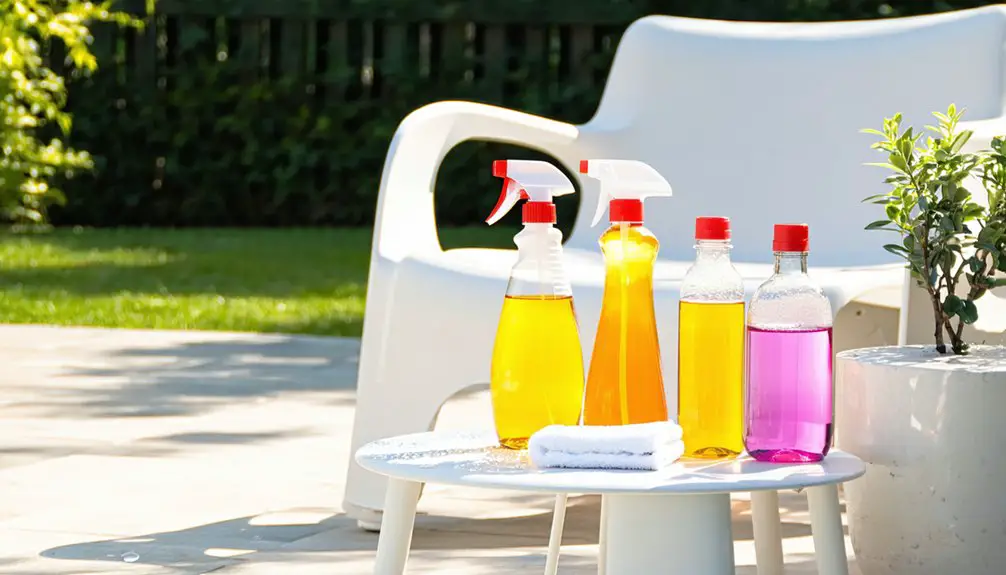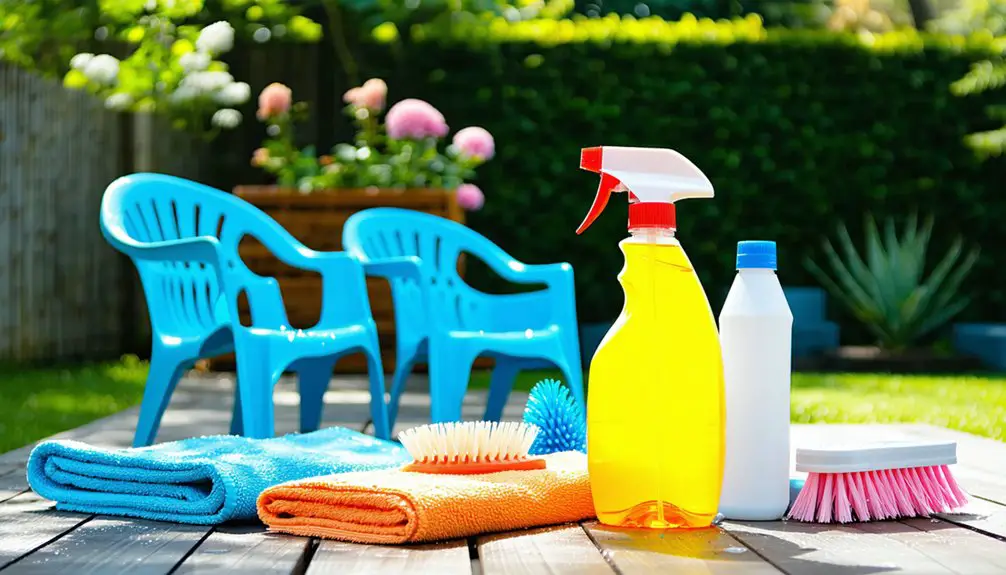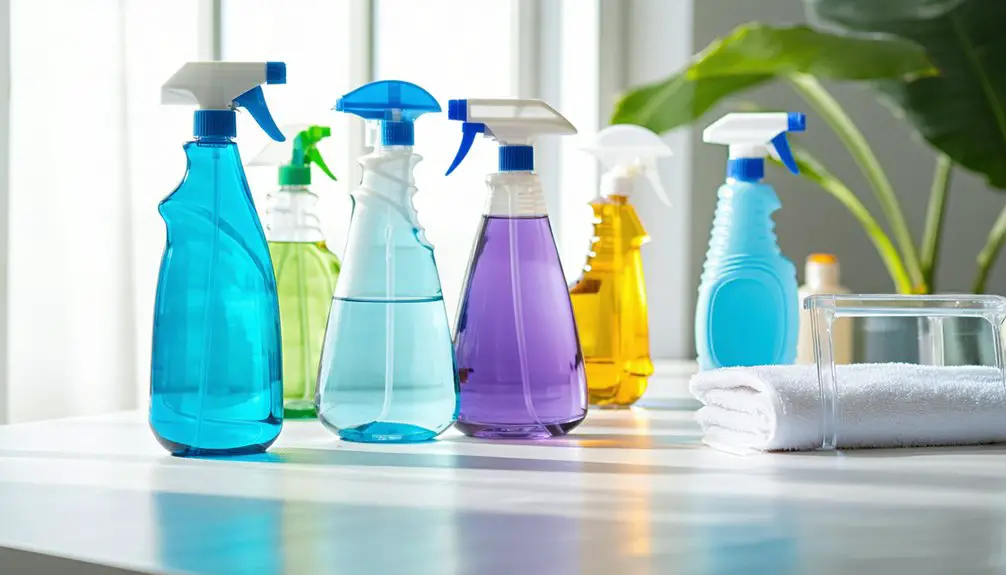To care for your plastic furniture, use a few effective products. A vinegar solution (1 gallon warm water with 1/4 cup vinegar) is a great natural cleaner. For tougher stains, try a bleach mixture (1 gallon warm water with 1/4 cup bleach). Mild dish soap mixed with water works well for regular cleaning. You'll also need soft sponges and a soft-bristle brush to protect surfaces. Remember to air dry your furniture in sunlight for the best results. If you want to know more about maintaining your plastic furniture, keep exploring additional tips and tricks.
Key Takeaways
- Mild Dish Soap: Effective for general cleaning, safe for plastic surfaces, and easily available for regular maintenance.
- White Vinegar: A natural and non-toxic stain remover, ideal for tackling mildew and stubborn marks on plastic furniture.
- Specialized Plastic Cleaners: Designed specifically for plastic maintenance, often featuring UV protection to prevent fading and damage.
- Baking Soda: Acts as a gentle cleaning agent that enhances cleanliness and effectively addresses tough stains without scratching.
- Melamine Foam Sponges: Perfect for tough stains, these sponges (like Mr. Clean Magic Eraser) are effective and easy to use on plastic surfaces.
Best Cleaning Solutions
When it comes to cleaning plastic furniture, several effective solutions are at your fingertips. One of the best methods involves mixing one gallon of warm water with 1/4 cup of bleach. This combination is great for tackling tough stains and grime. Just make sure you wear protective rubber gloves to shield your skin. Regular cleaning helps prolong the lifespan of your plastic furniture and maintain its appearance.
Once you've scrubbed the furniture with a brush, rinse it thoroughly with a garden or power hose and let it air dry in the sun.
If you prefer a natural approach, combine one gallon of warm water with 1/4 cup of white vinegar. Dampen a clean cloth with undiluted vinegar for everyday dirt, or add salt for stubborn stains—this acts as an abrasive without scratching the plastic.
For a more thorough clean, use a bucket with vinegar and warm water, scrub, and then rinse.
Mild detergents also work well; mix one gallon of warm water with two tablespoons of dishwashing soap and 1/4 cup of bleach for colored furniture. Rinse and dry with a soft towel or let it air dry outdoors.
Choose what suits your needs best!
Essential Cleaning Tools
When it comes to cleaning plastic furniture, having the right tools makes all the difference. A soft-bristle brush loosens dirt effectively, while a good sponge helps you apply your cleaning solutions without scratching the surface. Additionally, using a gentle cleaning agent like baking soda can enhance the cleanliness of your furniture. Regularly applying UV protectors to your furniture can also help prevent fading and damage from sunlight. Don't forget a dry vacuum to quickly remove loose debris and keep your furniture looking its best.
Soft-Bristle Brush Benefits
Soft-bristle brushes are often your best bet for cleaning plastic furniture without causing damage. Their gentle bristles are ideal for delicate surfaces, ensuring you can maintain your furniture's appearance without scratching or leaving marks. You can effectively use these brushes for dusting and cleaning textured surfaces, making them versatile for various tasks.
Here are some benefits of using soft-bristle brushes:
- Gentle on Surfaces: They clean fine particles and loose dirt without harming polished or sensitive areas.
- Versatile Use: Perfect for both regular cleaning and deep cleaning sessions, they adapt to different surface types.
- Effective Cleaning: They trap dust and debris efficiently, achieving a thorough clean with minimal effort. Additionally, they are a great choice for maintaining the durability of Polywood furniture due to their gentle yet effective cleaning action.
Not only do soft-bristle brushes provide effective cleaning, but they're also durable, often lasting as long as traditional brushes. With proper maintenance, you can use them frequently without losing effectiveness.
Plus, many are made from eco-friendly materials, aligning with sustainable practices. So, when it comes to caring for your plastic furniture, a soft-bristle brush is a smart choice!
Effective Sponge Selection
Choosing the right sponge is crucial for effectively cleaning your plastic furniture. The type of sponge you select directly impacts your cleaning results and the integrity of the surface. Here's a quick overview of popular sponge options:
| Sponge Type | Benefits | Drawbacks |
|---|---|---|
| Melamine Foam Sponges | Great for tough stains and scuff marks. | Can dull the finish on darker plastics. |
| Cellular Sponges | Excellent for cushioning, flexible. | Not suitable for abrasive cleaning. |
| Polyurethane Sponges | More hygienic, lower bacterial load. | Not effective for cleaning plastics. |
For tough stains, melamine foam sponges like the Mr. Clean Magic Eraser are your best bet. Just wet them and scrub firmly on stubborn marks. Cellular sponges, while flexible, are better for sealing applications and not recommended for cleaning. Polyurethane sponges are generally more hygienic, but you won't get the results you need for plastic furniture.
Additionally, using a mild washing-up liquid in combination with your sponge can enhance the cleaning process for lightly soiled plastic chairs. Remember to dampen your sponge before use and rinse it thoroughly afterward to maintain hygiene. Avoid abrasive options to prevent scratching and ensure your furniture remains in great condition.
Importance of Dry Vacuum
Keeping your plastic furniture in top shape requires more than just the right sponge; incorporating a dry vacuum into your cleaning routine can make a significant difference. A dry vacuum is designed to suck up dry debris, helping you maintain the appearance of your furniture by removing dust and dirt without damaging surfaces. Regular maintenance is crucial as it enhances the longevity of plastic furniture, ensuring it remains in good condition for years to come.
Its maneuverability makes it convenient for everyday use, ensuring your cleaning tasks become quick and efficient.
Here are a few reasons why a dry vacuum is essential:
- Versatility: With different attachments and nozzles, you can tackle various surfaces and hard-to-reach areas, not just carpets.
- Improved Air Quality: Many models feature filtration systems that trap dust, allergens, and germs, making your home healthier.
- Preventative Maintenance: Regular use prevents dust buildup, reducing wear and tear, and keeps your furniture looking clean and new.
Recommended Cleaning Frequency

To keep your plastic furniture looking its best, you should establish a regular cleaning schedule.
Aim to clean your garden chairs at least a couple of times each season, especially in high traffic areas.
Additionally, seasonal maintenance, like deep cleaning at the start and end of outdoor use, ensures your furniture stays in top shape.
Regular Cleaning Schedule
Cleaning plastic garden furniture at least once a week is essential for maintaining its appearance and preventing dirt buildup.
If you use the furniture less frequently, cleaning it once a month is usually sufficient. However, keep in mind that high-usage areas may need more attention, such as after every use or every few days.
The climate also plays a role; humid or rainy conditions could necessitate more frequent cleaning to avoid mildew and mold.
Here's a quick guide to help you establish a regular cleaning schedule:
- Weekly: Clean regularly used furniture to keep it looking fresh.
- Monthly: Tackle less frequently used pieces for upkeep.
- After Heavy Use: If you host gatherings or events, give your furniture extra care.
For general cleaning, mix a few drops of mild dish soap with warm water, and use a soft cloth or sponge to wipe the surfaces.
Rinse thoroughly to remove soap residue and dry with a towel to prevent spots.
Seasonal Maintenance Tips
Proper seasonal maintenance is crucial for extending the life of your plastic furniture and ensuring it remains attractive throughout the year. Each season comes with its own set of tasks to keep your furniture in top shape.
In spring and summer, inspect your furniture for any winter damage as you uncover it. Wash fabric cushions before their first use, ensuring they dry completely. Clean table tops and prepare your outdoor space for entertaining.
Don't forget to apply protective coatings to shield against the summer sun and rain, and check that all hardware is secure and free from corrosion.
As fall and winter approach, clean your furniture thoroughly before covering it to prevent mold and mildew growth. Use breathable covers for ventilation, and consider storing cushions indoors.
Applying a waterproof protectant spray will add an extra layer of defense against harsh weather conditions.
At the change of each season, inspect for signs of wear, remove debris, and use mild detergents with soft cloths for cleaning. Always test any cleaning products on a small area first.
Following these seasonal tips will help maintain the beauty and longevity of your plastic furniture.
Safety Precautions to Consider
How can you ensure a safe cleaning experience for your plastic furniture? First, it's crucial to wear protective gear to shield yourself from strong cleaners. Start with gloves to prevent skin irritation, and consider donning a mask to avoid inhaling any fumes.
Safety goggles can protect your eyes from splashes, while good ventilation helps reduce exposure to harmful vapors.
When choosing your cleaning agents, opt for products designed specifically for plastic. Avoid abrasive cleaners that could damage your furniture's finish. Mild dish soap mixed with water is a safe and effective choice, and white vinegar can serve as a gentle stain remover.
Be mindful of chemical hazards. Stay away from cleaning products that contain volatile organic compounds (VOCs), and never mix strongly reactive products. It's best to avoid ammonia and chlorine bleach due to their potential respiratory irritants.
Here are a few quick safety tips to keep in mind:
- Always read labels for safety instructions.
- Choose eco-friendly cleaning products when possible.
- Keep cleaning supplies out of reach of children and pets.
Additional Care Tips

To keep your plastic furniture looking its best, establish a regular cleaning routine and protect it from the elements. Start by using mild soap and water for general cleaning, employing a soft cloth or sponge to avoid scratches. Regularly dust and remove debris with a soft brush or cloth. For tougher stains, try a mixture of vinegar and water or baking soda. Remember to avoid abrasive cleaners or metal brushes.
Here are some essential care tips to enhance the longevity of your furniture:
| Care Tip | Description |
|---|---|
| Use Coasters | Prevent damage from hot objects by placing coasters. |
| Cover Furniture | Shield it during extreme weather or store it indoors. |
| Inspect Regularly | Check for cracks and address issues promptly. |
Additionally, consider applying UV-resistant coatings and storing furniture in a dry area during winter. Always test cleaning solutions on a small area first to ensure they won't harm the finish. By following these tips, your plastic furniture will stay looking great for years to come!
Avoiding Common Damage
Plastic furniture can easily fall victim to common damage if you don't take proactive steps. Protecting your furniture from scratches, fading, and environmental wear is key.
Start by using the right cleaning products; avoid harsh chemicals and abrasive cleaners. Instead, stick to mild dish soap, vinegar, or specialized plastic cleaners.
Here are some tips to help you avoid common damage:
- Cover Up: Use furniture covers during off-seasons to protect from dust, moisture, and UV rays.
- Inspect Regularly: Check for signs of damage or wear and address them quickly to prevent further issues.
- Handle with Care: Be gentle when moving or cleaning your furniture to avoid cracks and breaks.
Additionally, applying UV-resistant coatings can help shield your furniture from sunlight, preventing fading.
Establish a routine for cleaning and caring for your plastic furniture, and remember to use a soft cloth to avoid scratches.
Frequently Asked Questions
Can I Use Bleach on Colored Plastic Furniture?
You shouldn't use bleach on colored plastic furniture. It can damage the dyes and surface, leading to oxidation. Instead, opt for mild detergents or specialized cleaners to keep your furniture looking great.
How Do I Remove Tough Stains From Plastic Furniture?
To remove tough stains from plastic furniture, try mixing equal parts vinegar and water, or create a baking soda paste. Apply, scrub gently, rinse well, and let it air dry for best results.
What Is the Best Way to Store Plastic Furniture?
To store plastic furniture effectively, clean it first, use breathable covers, elevate it off the floor, and ensure it's in a dry, well-ventilated area. This prevents moisture damage and keeps it in great condition.
Are There Eco-Friendly Cleaning Solutions for Plastic Furniture?
Yes, you've got eco-friendly options! Try white vinegar, baking soda, or mild dish soap mixed with warm water. These solutions clean effectively without harsh chemicals, keeping your plastic furniture fresh and environmentally friendly.
How Can I Restore Faded Plastic Furniture Color?
To restore faded plastic furniture color, heat the surface gently with a torch to bring oils to the surface. Afterward, apply a UV protective clear coat to maintain the restored color and prevent future fading.

